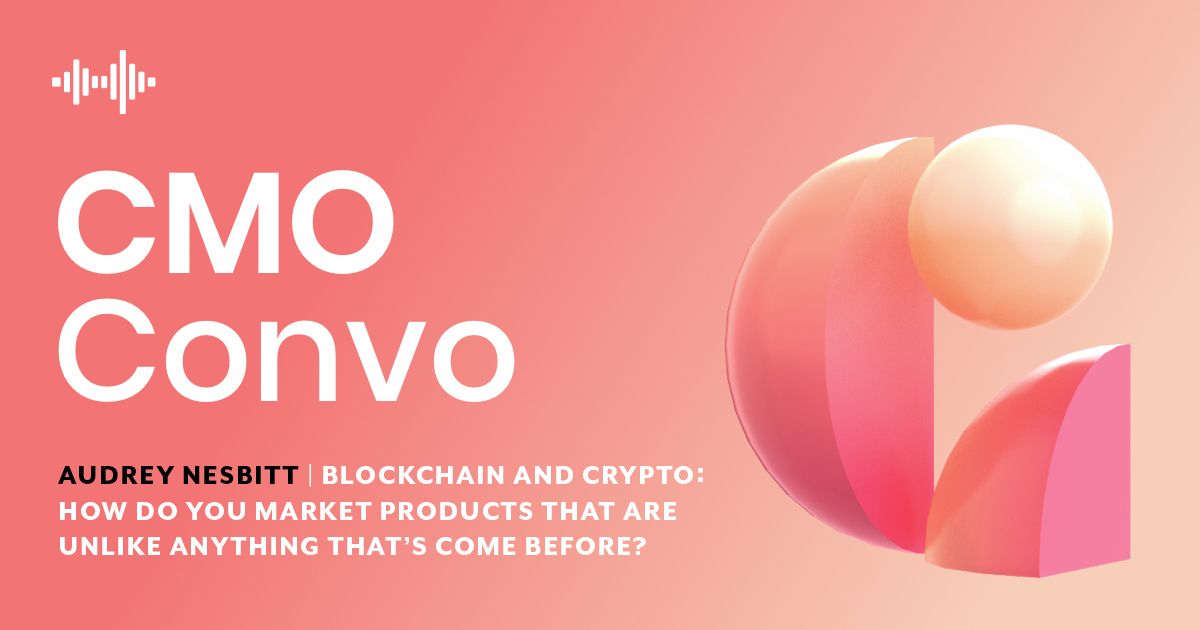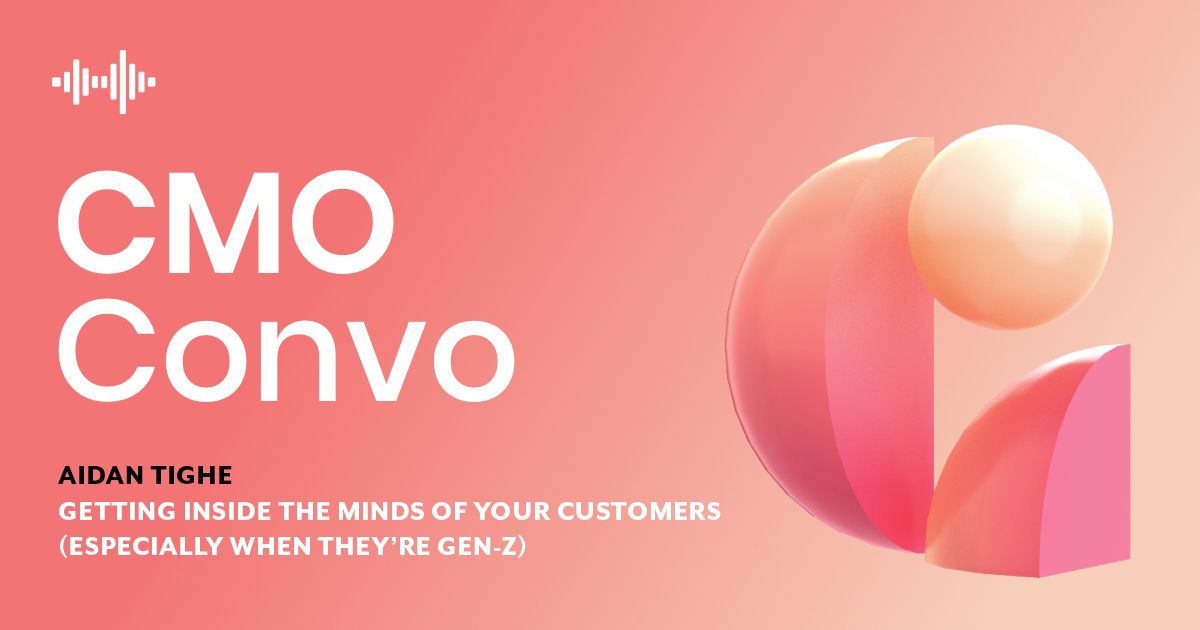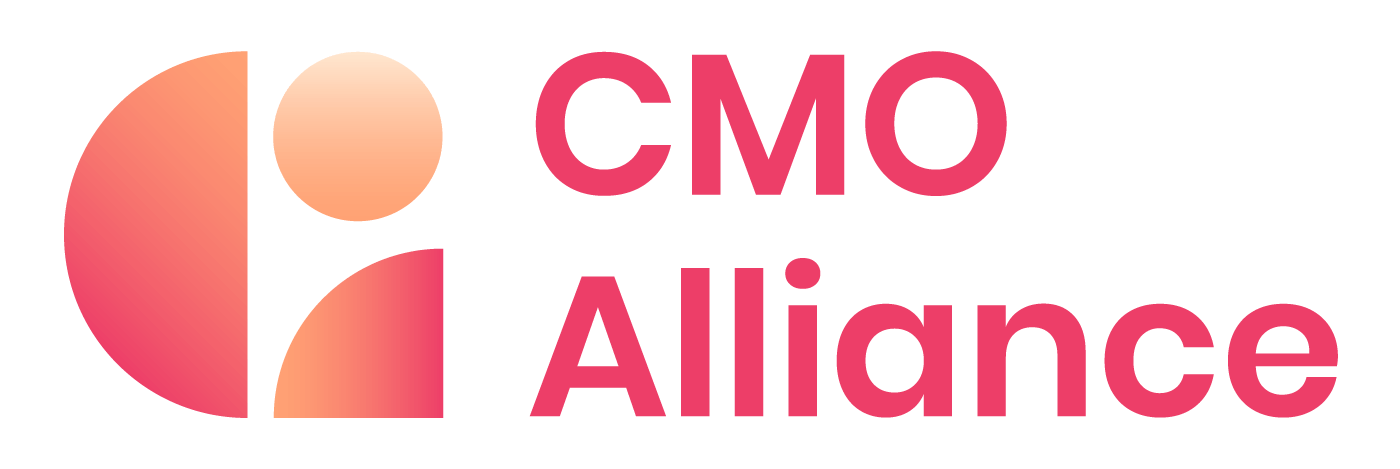For many people, blockchain and crypto are buzzwords that have slowly trickled through from tech blogs. So how do you market products in a world where most people don't even know exactly what they are? That’s a challenge our guest on a recent episode of CMO Convo, Audrey Nesbitt, overcomes every day, which is why she’s joining us to talk through the role of CMOs in marketing blockchain, crypto, and other little understood emerging technologies.
You can find the full episode right here, but read on for a write up of what we discussed.

Audrey's background and role as a CMO
The big world of blockchain and cryptocurrency is one that a lot of people have heard about, but not many people know too much about how the business works, let alone how the marketing works behind it.
But before we get into that, maybe you could to introduce yourself to our audience, Audrey, go into a bit of your professional background, and what your current role is like as a CMO.
Sure so the bulk of my career actually was head of marketing for a big US law firm. And then I started my own marketing firm, SpinSpirational Marketing, and moved into the blockchain cryptocurrency space in about 2017. It was the same time I joined CryptoChicks, which is a nonprofit educational hub for women and youth in blockchain and cryptocurrency.
Funnily it was founded by two women who have computer engineering backgrounds, and they couldn't figure out how to use a cryptocurrency wallet and how to start buying and trading in cryptocurrencies. So they started a meetup group to teach that and then that spiraled into this big educational hub. We have chapters now all over the world. And that's kind of how I started in the space.
That educational hub has expanded into a hatchery, which launches startups, helps startups come up into the space, and actually launch.
And the Academy, which is about educating people, not just on blockchain for businesses, but also basic leadership, launching, fundraising, and different emerging technologies, including AI, quantum computing, and so on. It's been a very exciting journey.
The role of education in emerging technologies
It sounds like a very interesting setup, you're basically providing the toolkit for people to create startups for the next wave of technology, as well as the cryptocurrency you've got quantum computing, AI, etc..
All these new exciting technologies that are emerging, people need educating about them, as they're completely new products, aren't they?
Yes, it's exciting.
Is that educational standpoint how you approach the CMO role? Is that something that you keep in mind as a sort of philosophy, a guide to when you're marketing for them?
Yes, in a CMO role I believe you're steering the organization on a growth path. And as a CMO, it's macro in scope, but focused on business impact. And a lot of what I believe the CMO does is embed purpose in what the company's doing and inspire people to achieve more than they ever thought possible.
So macro, especially in emerging technology is being the chief storyteller and educator. And it's like you said, we're educating people on new technology and to gain mass adoption, education and understanding the benefits of cryptocurrency and blockchain technology - because they are two separate things, is a big part of what I do.
The unique challenges of the world of blockchain and crypto
From a marketing standpoint, what are the challenges with promoting the blockchain and crypto space? What's unique about the products compared to more traditional products?
So first and foremost, like you you've touched upon the majority of the population doesn't know much about both and they're different. Blockchain is basically distributed ledger technology. So in itself, I like to say blockchain is actually kind of boring, right?
It's distributed ledger so instead of one person controlling a copy of the database, it's spread. So because it's on multiple computers all over the planet, there's no one central point of hacking.
And once something is uploaded to the blockchain, it's there permanently and everybody gets a copy of the record. So it's hard for anybody to commit some sort of fraud, they would have to change all the ledgers on everybody's computer, basically.
Cryptocurrency is the tokens or the currency that runs a lot of these new emerging technology economies. Blockchain can exist without cryptocurrency and in fact, it does. It's being used in supply chain with companies like Walmart, it's being used in banking and they obviously don't have a cryptocurrency.
But on the emerging technology side, the whole idea behind decentralization, meaning there's no central authority, blockchain is perfect for that decentralization and for that transparency. And the automation, the smart contracts that can be built. So automating contracts, basically taking emotion out of transactions, and taking out the third party in transactions is all automated on blockchain.
And when it comes to marketing a cryptocurrency project, why it's different, or how it's different is one, the education component that you've touched on is you're educating... to increase mass adoption, we're educating because there's still a big educational hurdle, per se, to the mass population.
So when you have a cryptocurrency project, you have the token, and you have the technology. And the token sometimes can drag the economy of that technology and it also can be used as a fundraising tool to raise the funds to build the technology.
So when it comes to marketing, part of your target market one is the people that are going to buy the token, so cryptocurrency traders, investors, and they tend to already be in the cryptocurrency market. Then on the other side, on the product side, all the time on the technology side, then you're going after the user, the end-user.
That could be a gamer, or it could be a game development company. It could be a musician, it could be an artist, like recently with the big NFT craze and artists selling your digital artworks as non-fungible tokens and getting millions of dollars for it.
So in that regards to that type of NFT platform, you've got to raise the token, you've got to sell the token, raise the funds, build out the platform, then attract the artists to bring their artwork and build their artwork and mint them as NFT's and then attract the NFT buyer.
So you have different demographics that you're targeting and a lot of times they can crossover. But often you're doing different campaigns strategically targeting those different users.
Identifying your audience
So it sounds really tricky to pin down who your target audience is in order to stay focused, that's got to be a challenge when you're coming up with these strategies.
How do you identify your buyer personas? How do you identify your audience, when it is so broad?
Well, that's tricky in the startup space generally, a lot of times getting startups to focus on who their niche is can be a challenge. A lot of times startup companies in any space, not just in cryptocurrency, want to be everything to everybody. And when you try to be everything to everybody, you're effective to nobody.
So for me when I'm building the strategy, it's really specifically targeting each one and laying out what that map looks like, and what that profile looks like and who that person is, and creating strategic campaigns that target them specifically.
So, for example, to drive the token and increase brand awareness, LinkedIn is a great tool. To gain influence in brand awareness, Twitter. Community driving, when we're trying to get developer onboarding or the end-user it could be Reddit, it could be Telegram.
In regards to NFT's and artists, then it's completely different because you could be targeting those crypto users but you could also be targeting depending on the type of artwork you're pursuing, you could be going into real-world art circles and finding real-world artists, and convincing them to bring their artwork, the beautiful creations that they already do in the physical form, and bringing it to the digital form.
It sounds really exciting. The opportunity to get into all these different mindsets and build a multistage campaign around them. It's not just one target audience you've got to keep track of it's all these different target audiences and getting into the psychology and the motivations behind why they should be interested, and why they should be investing in crypto and blockchain as a technology.
How do you do it? It sounds like an almost mammoth task. Lots of CMOs and marketers struggle just to target one specific target audience, how do you keep track of all these different personas?
Well, to me, that's what makes it exciting. Because in 2017, when I started, think of how small that niche group was. We kind of joke that in 2017, we were really lonely at the party, in the corner of the room sitting by ourselves, trying to talk about Bitcoin and Ethereum. This past year, it's really started to seep into mainstream conversations. So NFT, it's attracted Elon Musk, and other celebrities, and musicians.
And one of the companies that I think are doing a great job is Dapper Labs with NBA Top Shot. I don't know if you've heard of it but it's digital collectibles, with the NBA. And what I like about what they've really done is they haven't talked so much about the technology.
One of the challenges when I come into a startup, from a marketing perspective, is how much does the end-user really give a shit about the technology?
It's the driving force, obviously, it's what's driving the whole platform but to the end-user... a good example I like to make is the Fitbit. How many users of the Fitbit can do a deep dive into the sensor technology that's driving their Fitbit? Or do they care more about, "It's counting my steps and calories and my heart rate" and all of those things?
So NBA Top Shot, I believe, has done a great job of bridging cryptocurrency blockchain with mass users because they're just talking about digital collectibles. They're not referring to them as non-fungible tokens that can be moved on to cryptocurrency exchanges, etc, etc.
So, to me, that's one of the talents that I bring and one of the challenges is being that storyteller that knows what story am I telling to what market? What story are we crafting about a product to the investor? What story are we crafting for the end-user? And they're different. They're very different stories.

Focussing on the benefits, not features
And it's about the destination. When you mentioned Fitbit, when it first came out, along with other wearable technologies, many people were like "Oh, what's the point, no one needs them. We don't need wearable technology". Now they've become mainstream because people have realized the benefits of them, people have seen the adoption by influencers and people they trust.
That goes back to one of the great pieces of marketing, when Steve Jobs was on stage introducing the iPod. He didn't talk about the technology behind it, he didn't talk about the features. He said this is 1000 songs in your hand and that's a similar ethos that you have to carry across when it comes to these kinds of emerging technologies.
Not everyone's going to be able to understand all the tech behind it, but they could understand the ultimate benefits of it to themselves.
Absolutely. And actually, you just brought up what could be a great slogan, not 1000 songs in the touch of your hand, but international banking in the palm of your hand, so to speak.
We talked a bit about how you have multiple different campaigns running at different times, what do these campaigns look like that are different from a standard marketing campaign?
Do you still approach it in the way that you've approached marketing other technologies when you build this narrative? Or does the narrative have to be different because it's a very tech-savvy audience you're going after, will they expect a very tech-savvy campaign? Does it have to be flashy? Or can it be quite simple?
Well, again, that depends. In regards to NBA Top Shot, they're not tech-savvy, your end-user doesn't have to be tech-savvy. This is why I think they've done a great job of penetrating non-crypto users.
To me, marketing is all the same and the channels just might be different, or the story is different. But at the end of the day, you're still who's our target market? What is it that they want? How do we talk to them? And then listening to them to find out how we need to pivot.
In emerging technologies what's always interesting is you could come into the market thinking this is our target user. And then when you look at the data, and you start gaining those consumer insights, you find out that what they see is not your initial vision, and you have to be able to pivot.
So a good example of that, and what we see a lot in cryptocurrency and emerging technology is we have, because of regulation, where the campaign's going to launch. So a lot of times campaigns can't launch in the United States because of the SEC and regulation.
So when we're coming up with a marketing strategy, what's the market we're going to be in and pursue? And they can be very different from the east to the west. In general terms, the East likes more flashy, more things on, they look at Google like it's incomplete. And then in the West, we like clean, straightforward, simplicity. Google.
A good example, if you're in the cryptocurrency world is Coin Base compared to Binance and just looking at their UX on how different they are. Uniswap compared to Sushi Swap.
What I try to do is, especially in regards to UX, as you're reading the data, and you can get data on what's being used, what's not being used, where are they going on the page? And then, are your users predominantly coming from the east or from the west? And how do they like the UX? And are you ready to pivot?
Meaning are you ready to put more stuff right there on the screen and make it more flashy? Is that your demographic? Or are we removing stuff and cleaning up the UX for the West? You always have to be ready to pivot, especially in new markets, when you're forming and one of the big things I really stress is talk to your users, get those fans.
Cryptocurrency is very community-driven. Same with developers, coders, game developers, they're very community-driven. And you can learn a lot by getting ambassadors, who are your users, and who are your key users, and who's contributing? Put them on your team, reward them and talk to them and find out what they're seeing and what they're doing because they're your demographic.
That's your target, I don't want to say influencers in the way we generally look at influencers, as somebody with a huge following like Kardashians or Elon Musk, I'm talking about your little micro-influencers that are in your chat groups, in your Telegram or Discord.
And they're commenting a lot, and they're talking a lot, and they're participating a lot. Those can be your rockstars, find them and reward them for being a part of your community and make them a brand ambassador because they're key.
How do you identify who would make a good ambassador? Is it just spending time on these communities and picking people out? Or would you identify them and send them into those communities to represent you?
No, the ones that end up being rock stars are the ones that come in because they're a fan of what you're doing, they're a fan of your product. You'll see them commenting a lot, you'll see them defending you a lot.
A lot of times in emerging technology, there are delays, there are bumps in the road, and they're the ones that will be in there defending the development team, defending the vision. It’s kind of like who's commenting the most in the Facebook group, and on the positive side. Obviously, not the trashers.
But in a few communities that have been part of my marketing campaigns, you see them, you see the ones that are there, they're present, they're commenting, they're psyched, they're sharing, they're excited. And those are the ones you start talking to because they're your fans.
It's like who do you put the head of your fan club, your rock and roll fan club, or your rap fan club, it's usually your top fans and they tend to start standing out from the rest of the crowd.
And they understand the community in those platforms in ways that might be difficult for you to engage with. If you're not familiar with how things on Twitch or Discord work, then having these ambassadors, having these people has got to be a really valuable insight into understanding different platforms?
No, absolutely. Because I'm not a 25-year-old male Fortnight player. I'm not a 15-year-old Roblox player.
But what makes me great at what I do is understanding I'm not the demographic, it's not up to me to get it, it's up to me to understand who to ask in that key demographic, and utilize the people that are in that key demographic, and get the information from them and then give them the tools to amplify the product and the product voice.
When it comes to setting up the campaigns, you said marketing is all the same, is it the same with the goals of a crypto or blockchain campaign? Is it still broken down to brand awareness, conversions, lead generation, etc.? Or do you have different goals when it comes to these kinds of campaigns?
So I think you've hit on a couple. Yes, again, macro the goals are the same - increase brand awareness, generate high-quality leads or opportunities, whether they're considered leads, opportunities, or branding opportunities, that depends on the project.
A big one in I think anywhere is growing and maintaining thought leadership, get that mindshare, that real estate is so valuable that mindshare real estate.
Be customer-centric, again, do a deep dive into who your end-user is. Then empower your team and part of that team are those community influencers. Those Redditors that love your product, those Twitter influencers that believe in your vision.
And one additional goal of a cryptocurrency campaign is the investors. It's not like we want to make the value of the token the priority, but it's a big part of who's talking about your project. It's one of the benefits because it's driving money into the industry and then you can say it's one of the detriments because you have to be concerned about investor value.
Say you're the CMO of a crypto startup, and you're trying to work out what to prioritize, what dictates what your priorities should be? What should your goals be from day to day to more long term? What are the ultimate goals when you're developing strategies?
A lot of that comes down to money. How much is the budget? If we have a large budget, I actually tend to tell when a company consults me in regards to marketing campaigns in cryptocurrency specifically, because right now there is so much competition for mind space in the cryptocurrency space.
There are so many projects coming up in this space. So you need marketing and PR macro, a big PR firm that's going to get you mainstream media, that's part of that education and brand awareness piece. It builds legitimacy when you're going to go and sell a token.
It also helps start bridge that legitimacy when you're with the technology going after whether it's developers, whether it's game developers or game players, depending on the project. So thought leadership, I think should always be a goal, even in the initial startup phase where a founder might not even be thinking about marketing.
But they could be establishing themselves as a thought leader in the space and never mention what they're doing, they can just start talking about the technology in general and building up their influence in the space. So when it comes the time that they reveal to the world their product, they're not behind.
I find it's one of the mistakes a lot of startups, regardless of industry make - they think they have to wait until the product is perfect and then they start thinking about the marketing piece instead of thinking about the marketing piece and executing on some marketing as they start to gear up.
And as I said, a lot of that is thought leadership, increasing your following in that space, talking on points in that space, then "Oh, and by the way, I'm launching this product".
It's classic thought leadership, giving legitimacy to what you're presenting as a solution to an issue. You've already established yourself as an expert. And now you've got the solution to the problems that you've been talking about.
I think core marketing has never changed. The core philosophy behind it has never changed. It's the channels of how we communicate that have changed. The tactics, those specific tactics have changed. But not the whole idea, or the reason behind it.
That should always be key. I think one of the things that have shifted, or I guess the better way to put it is we've become more aware, is how important the customer is.
The customer should have always been important, but a lot of marketing strategies, to me, it's disappointing, a lot of it is marketing for the sake of marketing. We're just going to amplify and we're going to just push out this message. And there's no context or storytelling or emotion behind it.
You said it with Steve Jobs and what Steve Jobs was brilliant at was building the emotion and the human connection before even selling the product, or pushing forward the product. So to me, customer-centric marketing, crafted storytelling with emotion and context is so important in a successful marketing campaign.
It's unique with emerging technologies. You've also got to educate and you've also got all these different types of customers as well. So it's approaching them in different ways. As you said, you've got your developers, you've got artists, you've got a list as long as your arm...
Right, there are always pros and cons but that's one of the things that makes it exciting, it makes it challenging but it also makes it exciting. Because it's not just straightforward, here's product A, and product B is our target market and we've already spent hundreds of 1000s of dollars to decide that that's our target market.
Whereas with startups, and especially in the cryptocurrency space and blockchain space, that's exciting. I find one of my challenges is actually getting the founders of the startup to understand and know how to communicate their value prop, and not try to be all things and not try to oversell the technology.
The technology is important and the technology might be their value prop but when you're converting that into layman's terms, is it saving me time? Is it saving me money? Is it making something easier? Do I love the look and feel of the car? Is Jay Z driving it?
Know what I mean? Like, is it counting my steps? Is it accurate in counting my steps? Is it 1000 songs in my hand? That's the end message to a lot of users. That's all they care about. Well, the other stuff matters but the driving messaging is more emotion and human-based, as opposed to what the technology can do.
The features and the technology might be interesting in certain circles, you might get good PR from within the cryptocurrency field. But if you want the mass adoption that you need, you need to be talking about the benefits to the masses, not just all the bells and whistles.
Right. To me, great technology and a great product, it's great when you can market something that's great. Right? When you're dealing with something where there's care from the developers or from the founders on product delivery, which basically brings it down to customer-centric.
Who is that customer? Are you making them happy? When you have that, marketing is easier, it is so much easier to market something that's great. Now, there's nothing wrong with being not top quality.
Look at Walmart, Walmart's business plan has nothing to do with product quality, it has everything to do with being the lowest price. And there's nothing wrong with that. It's knowing what you're marketing.
So it's are you trying to market the lowest price as a premium product? Then there's ethics, not legal ethics, but as a marketing person, how good does that feel? It feels blah.
It means as well you've got to be reactive with your marketing, you're trying to fix problems with your marketing rather than being proactive. You're not talking about what's great, you're tiptoeing around the problems, which is never a good thing when it comes to marketing. You want to be out there saying "this is a great product, this is what you can do with it".
Right, this is great or this is the cheapest. There are markets for both. There are successful businesses operating on both of those levels. But when the company doesn't care, and they're just trying to throw something out there it's very disheartening. And I try not to do those campaigns.

Five golden rules of marketing crypto and blockchain
To close things out, could we break things down into the five golden rules of a good cryptocurrency/blockchain campaign, which could probably apply to pretty much any emerging technology.
For me, number one, especially with technology when you're talking about emerging technology or technology, a lot of times different department heads and core founders see things differently and they have different messaging. So to me, make sure everyone's on the same page in regards to messaging and your target market.
Be customer-centric, number two, definitely be customer-centric.
Be data-driven. Utilize what you can in regards to data aggregation, analytics and understand what it is you're measuring, and how you're implementing those metrics to make a change or pivot your marketing campaigns.
Don't overlook or underestimate the competition. And don't think narrowly in regards to the scope of competition. Look at outside finance companies or banks not looking at Google or Alibaba as competition or Facebook as competition. They all want to release financial instruments. They are competition.
And be ready to pivot. I think you always need to listen really well and be ready to pivot. That's what I would say my five are.
Great rules for running a crypto campaign, but also great rules for any marketing campaign. As you said, marketing doesn't change, the product might change, but the core principles of marketing don't change.
No, they don't!
Need tips on marketing emerging technologies? Got insights of your own to share? Head to the CMO Alliance Community!




